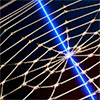
Researchers create one of the world’s most precise microchip sensors – thanks to a spiderweb
(Nanowerk News) A team of researchers from TU Delft managed to design one of the world’s most precise microchip sensors; the device can function at room temperature – a ‘holy grail’ for quantum technologies and sensing. Combining nanotechnology and machine learning inspired by nature’s spiderwebs, they were able to make a nanomechanical sensor vibrate in extreme isolation from everyday noise.
This breakthrough, published in Advanced Materials (“Spiderweb Nanomechanical Resonators via Bayesian Optimization: Inspired by Nature and Guided by Machine Learning”), has large implications for the study of gravity and dark matter, as well as the fields of quantum internet, navigation and sensing.
One of the biggest challenges for studying vibrating objects at the smallest scale, like those used in sensors or quantum hardware, is how to keep ambient thermal noise from interacting with their fragile states. Quantum hardware for example is usually kept at near absolute zero (−273.15°C) temperatures, with refrigerators costing half a million euros apiece.
Researchers from TU Delft created a web-shaped microchip sensor which resonates extremely well in isolation from room temperature noise. Among other applications, their discovery will make building quantum devices much more affordable.
Hitchhiking on evolution
Richard Norte and Miguel Bessa, who led the research, were looking for new ways to combine nanotechnology and machine learning. How did they come up with the idea to use spiderwebs as a model?
Richard Norte: “I’ve been doing this work already for a decade when during lockdown, I noticed a lot of spiderwebs on my terrace. I realised spiderwebs are really good vibration detectors, in that they want to measure vibrations inside the web to find their prey, but not outside of it, like wind through a tree. So why not hitchhike on millions of years of evolution and use a spiderweb as an initial model for an ultra-sensitive device?”
Since the team did not know anything about spiderwebs’ complexities, they let machine learning guide the discovery process.
This breakthrough, published in Advanced Materials (“Spiderweb Nanomechanical Resonators via Bayesian Optimization: Inspired by Nature and Guided by Machine Learning”), has large implications for the study of gravity and dark matter, as well as the fields of quantum internet, navigation and sensing.
One of the biggest challenges for studying vibrating objects at the smallest scale, like those used in sensors or quantum hardware, is how to keep ambient thermal noise from interacting with their fragile states. Quantum hardware for example is usually kept at near absolute zero (−273.15°C) temperatures, with refrigerators costing half a million euros apiece.
Researchers from TU Delft created a web-shaped microchip sensor which resonates extremely well in isolation from room temperature noise. Among other applications, their discovery will make building quantum devices much more affordable.
Hitchhiking on evolution
Richard Norte and Miguel Bessa, who led the research, were looking for new ways to combine nanotechnology and machine learning. How did they come up with the idea to use spiderwebs as a model?
Richard Norte: “I’ve been doing this work already for a decade when during lockdown, I noticed a lot of spiderwebs on my terrace. I realised spiderwebs are really good vibration detectors, in that they want to measure vibrations inside the web to find their prey, but not outside of it, like wind through a tree. So why not hitchhike on millions of years of evolution and use a spiderweb as an initial model for an ultra-sensitive device?”
Since the team did not know anything about spiderwebs’ complexities, they let machine learning guide the discovery process.
www.nanowerk.com



